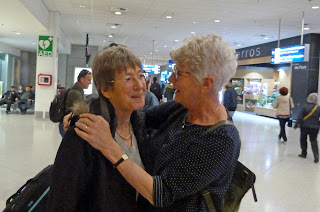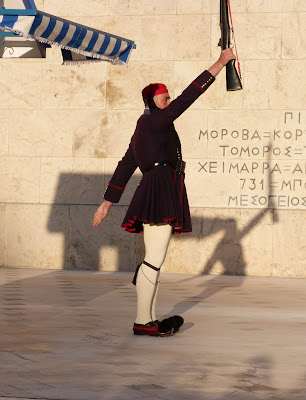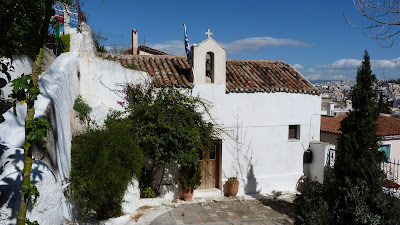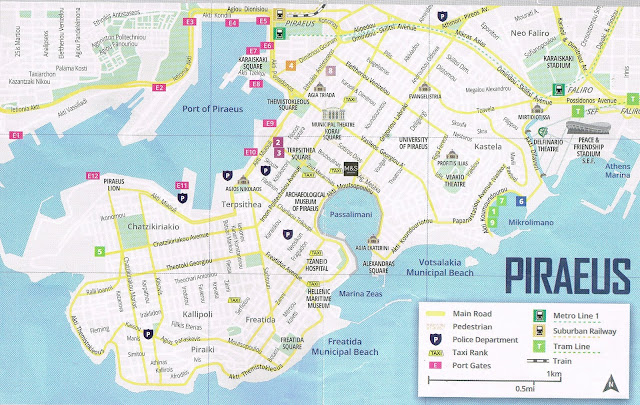Thursday (day 1) : Arrival - Friday (day 2) : Akropolis - Agoras - Syntagma (Change of the Guards)
After meeting in Vienna in 2016, a citytrip to Krakow in 2017, we choose Athens for this years citytrip, hoping that we might have some mild weather after this cold winter.
Thursday 22 March
Train at 8h10 via Ghent (Mieke joined) arrival Zaventem 9uh35
Aegean vlucht A3621 at 11u50 ETA Athene 16u00 (local) = 15u Belgium
Flight from Vienna (and France) were cancelled due to strikes. Kate was re-booked for next day.
A very nice driver took us through the center of Athens to our hotel 'Arion', situated in a popular area, pleasant and busy with lots of restaurants.


 |
| View of Akropolis from the top terrace |

 |
| Diodos restaurant in Adrianou street |

 |
| Nightview from the hotel terrace |
Friday 23 March : After breakfast at 8:30 am, Mieke and myself set off for to visit the Acropolis.


 |
| Plateia Monastiraki |

 Our walk took us from Manastiraki via Hadrian's library, Taxiarchon (church) and the Roman Agora and Dioskouron street up the steps to Theorias and the west head entrance to the Acropolis.
Our walk took us from Manastiraki via Hadrian's library, Taxiarchon (church) and the Roman Agora and Dioskouron street up the steps to Theorias and the west head entrance to the Acropolis. I got free entrance with my guide card, Mieke bought a combined ticket for 5 sites for 15€.
 |
| Vivliothiki Adrianou |
 |
| Agii Taxiarches Ke Panagia Grigoroussa |

 |
| Entrance pillars of the Roman Agora |

On our walk to the Acropolis we had our first view of the Thiseio temple in the Ancient Agora

 The monuments of the Acropolis have withstood the
ravages of past centuries, both of ancient times and those of the Middle Ages.
Until the 17th century, foreign travellers visiting the monuments depicted the
classical buildings as being intact. This remained the case until the middle of
the same century, when the Propylaia was blown up while being used as a
gunpowder store. Thirty years later, the Ottoman occupiers dismantled the
neighbouring Temple of Athena Nike to use its materials to strengthen the
fortification of the Acropolis.
The monuments of the Acropolis have withstood the
ravages of past centuries, both of ancient times and those of the Middle Ages.
Until the 17th century, foreign travellers visiting the monuments depicted the
classical buildings as being intact. This remained the case until the middle of
the same century, when the Propylaia was blown up while being used as a
gunpowder store. Thirty years later, the Ottoman occupiers dismantled the
neighbouring Temple of Athena Nike to use its materials to strengthen the
fortification of the Acropolis. The most fatal year, however, for the Acropolis, was 1687, when many of the building’s architectural members were blown into the air and fell in heaps around the Hill of the Acropolis, caused by a bomb from the Venetian forces. Foreign visitors to the Acropolis would search through the rubble and take fragments of the fallen sculptures as their souvenirs. It was in the 19th century that Lord Elgin removed intact architectural sculptures from the frieze, the metopes and the pediments of the building. In 1833, the Turkish garrison withdrew from the Acropolis.
 |
| Odeio Rodiou Attikou (Herodes Attikus) theatre, seen from above |


The principal entrance to the acropolis had always been on the west side of the escarpment since Mycenaean times and the Propylaea was built on the exact site of the Old Propylon (a modest columned porch) built from 490 BCE and destroyed by the Persians in 480 BCE.
Constructed with white Pentellic marble, the new Propylaea lies on an east-west axis and was designed to mirror the architectural style and proportions of the nearby Parthenon.


The Parthenon was built in the mid-5th century BCE and dedicated to the Greek goddess Athena Parthenos (“Athena the Virgin”). The temple is generally considered to be the culmination of the development of the Doric order, the simplest of the three Classical Greek architectural orders.

Built about 420 B.C., the Erechtheion is an Ionic temple divided into two sections -- one for Athena, one for Poseidon -- beautified with garland, palm, and lotus ornamentations.
The most celebrated element, though, is the Porch of the Caryatids, in which columns were replaced by statues of maidens in tunics.






 |
| View on the Theatre of Dionysius & the new Akropolis Museum |
 |
| View on the Stiles Olypiou Dios in the National Garden |
 |
| View of the Lycabette Hill & Agios Georgios (church) |
 We left the Akropolis through the same west gate in Theorias and took left into the Dionysiou Areopagitou, now a beautiful pedestrian lane which used to be a 4-lane motorway.
We left the Akropolis through the same west gate in Theorias and took left into the Dionysiou Areopagitou, now a beautiful pedestrian lane which used to be a 4-lane motorway.




We arrived at the back of the Roman Agora

 The Agora (Αγορά) of Athens today is an archaeological site located beneath the northwest slope of the Acropolis. The word "agora" applies to an assembly of people and by extend marks the gathering place. In modern Greek the term means "marketplace".
The Agora (Αγορά) of Athens today is an archaeological site located beneath the northwest slope of the Acropolis. The word "agora" applies to an assembly of people and by extend marks the gathering place. In modern Greek the term means "marketplace".
For the most part, for the visitor today, the Agora is not important for the splendor of its buildings, but for the significance of its history.
Contrasting with the austere ruins in the middle of the archaeological site however, two splendid buildings stand as testaments to its past glory: the humble Temple of Hephaestus, which is the best preserved ancient Greek temples from the Classical era, and the impressive Stoa of Attalos -a building of the Hellenistic period that was rebuilt from the ground up based on its ancient appearance.
In the 19th century the four colossal figures of Giants and Tritons at the facade of the Gymnasium were restored by the Greek Archaeological Society.

 |
In the years 1953-56, the Stoa of Attalos was reconstructed to become a museum and in the same period the Byzantine church of Aghioi Apostoloi, built around A.D. 1000, was restored by the American School.


 |
| The Temple of Hephaestus |
We returned to Monastiraki to take the metro the fetch Kate from the airport.
Athens has a very good transportation network.

 |
| The airport metro station |
 Our afternoon walk took us back around the entire Dionissiou Aeropagitou beneath the Akropolis , with a diversion to Phika from where there is a fantactic view on the Akropolis and the city.
Our afternoon walk took us back around the entire Dionissiou Aeropagitou beneath the Akropolis , with a diversion to Phika from where there is a fantactic view on the Akropolis and the city.We decided not to climb to the Filopappou mausoleum on top of the "Museum Hill"




 |
| One of the many beautiful houses along the Dionissiou |

 The Arch of Hadrian was commissioned by the Roman emperor in the 2nd Century as a symbol of his power. This once lofty and gated archway was meant to figuratively separate the old city of Athens, pre-Hadrian, from the new city under Roman rule. Hadrian even had it inscribed accordingly on either side, portions of which can still be seen some 1,900 years later.
The Arch of Hadrian was commissioned by the Roman emperor in the 2nd Century as a symbol of his power. This once lofty and gated archway was meant to figuratively separate the old city of Athens, pre-Hadrian, from the new city under Roman rule. Hadrian even had it inscribed accordingly on either side, portions of which can still be seen some 1,900 years later.The Zappion is used as an exhibition hall and for official events. It was built in 1878 and donated to the nation by the Zappas brothers from Ipirus. This building was the first to hold an indoor Olympic event, in the 1896 Olympics.
In fact even though credit as the founder of the modern Olympics goes to Pierre de Coubertin, and his name is mentioned in every Olympic ceremony and in the media, in truth, Coubertin only founded the International Olympic Committee (IOC).
 With nearly 40 acres of well-kept gardens, sky-high forests and ancient ruins the National Gardens of Athens offers travelers a natural escape unlike any other. Commissioned by Queen Amalia in 1838, this unique destination is home to more than 500 species of plants and animals and a vast landscape dotted with the busts of Greek poets, gods and political figures.
With nearly 40 acres of well-kept gardens, sky-high forests and ancient ruins the National Gardens of Athens offers travelers a natural escape unlike any other. Commissioned by Queen Amalia in 1838, this unique destination is home to more than 500 species of plants and animals and a vast landscape dotted with the busts of Greek poets, gods and political figures. |
| The Parliament building on Syntagma square. |
The Changing of the Guards in Athens Greece: Every Sunday morning at 11 am, people gather in Syntagma Square to watch the official changing of the guards, the military unit whose members stand proudly in perfect stillness in front of the Hellenic Parliament. There are of course changings every hour in the day, but on Sundays it is the official ceremony with the official costums.
 The Evzones is a special unit of the Hellenic Army, also known as Tsoliades, who guard the Monument of the Unknown Soldier in front of the Hellenic Parliament and the Presidential Mansion.
The Evzones is a special unit of the Hellenic Army, also known as Tsoliades, who guard the Monument of the Unknown Soldier in front of the Hellenic Parliament and the Presidential Mansion. The duties of the soldiers are part of a ceremonial nature. Every soldier guards for about an hour, 3 times in total every 48 hours. Throughout these 60 minutes, they have to stand perfectly still until it is time to switch with another guard.


During the changing, they work in pairs so they can perfectly coordinate their moves. The steps that the official ceremony requires at the time of changing are carried out in really slow motion to protect their blood circulation after 60 min of immobility.
 By now it is becoming dark so we walk home, crossing Syntagma square into Ermou, the pedestrian shopping street t Monastiraki.
By now it is becoming dark so we walk home, crossing Syntagma square into Ermou, the pedestrian shopping street t Monastiraki. Here again, as in many streets, a church stands in the middle of the street.
Here again, as in many streets, a church stands in the middle of the street.

We return to Adrianou street but choose a different restaurant, Antika, in front of the Stoa





















































Reacties
Een reactie posten